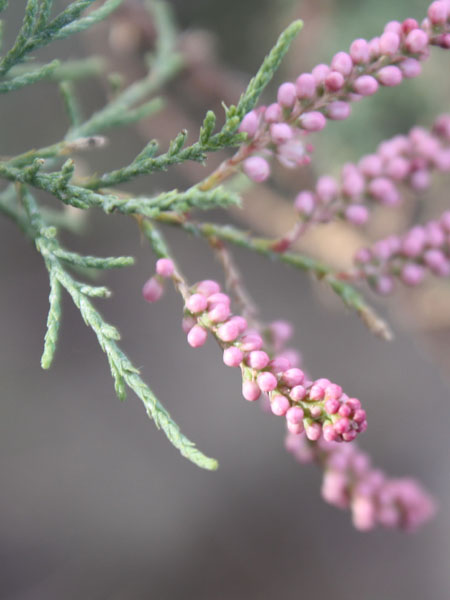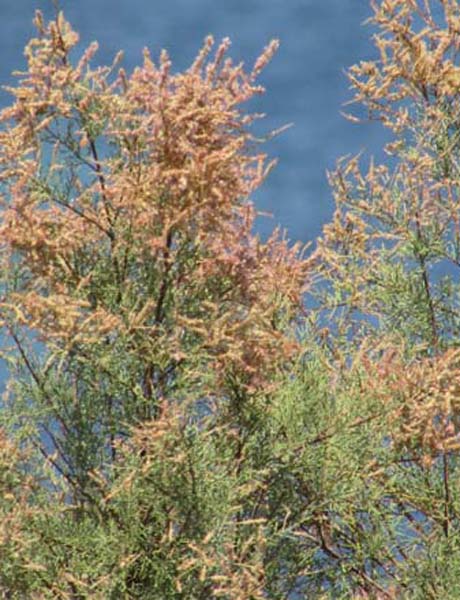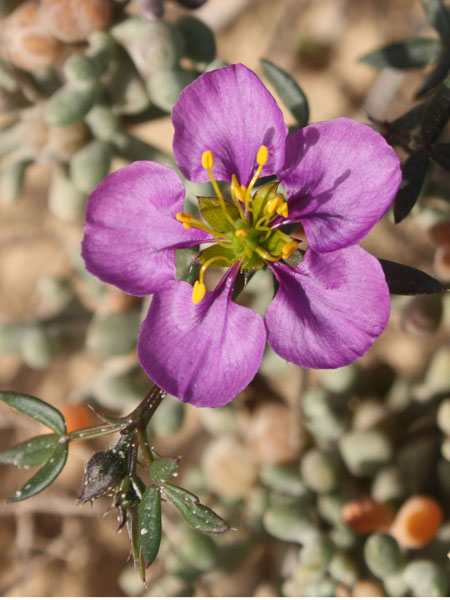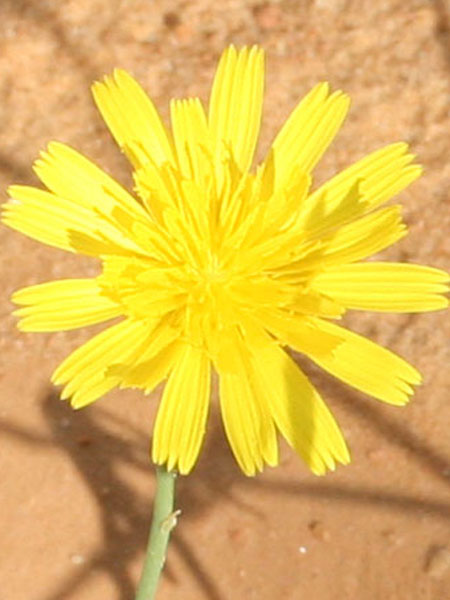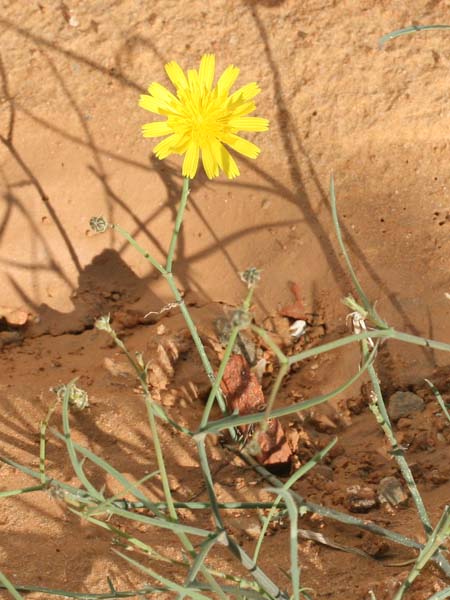Reaumuria vermiculata
Kingdom : Plantae / النّباتات
Division : Spermaphyta / البذريات
Clade : Magnoliophyta or Angiospermae / مستورات البذور
Class : Eudicotyledoneae / ذات الفلقتين
Order : Caryophyllales / رتبة القرنفليات
Family : Tamaricaceae / فصيلة الطرفائيات
Genus : Reaumuria
species : vermiculata
Chromosomes: 2n=22
Protologue
L., Syst. Nat., ed. 10, 2: 1081 (1759)
Synonyms
Reaumuria mucronata Jaub. & Spach, Ill. Pl. Orient. 3: 57, t. 245 (1848).
Common names
Tunisia Arabic English French Tamazight
ام النّدى
Reaumure
Khechal
Toxic
yes
Edible
no
Latex
no
Botanic description
Genus description
"
Species description
"Gypso-halophyte shrub, glabrous, from 50 to 1m.
Stems erect, whitish, numerous. Leaves a glaucous green, semi-cylindrical, fleshy, punctuated, very close to the ends of the branches (5mm). Flowers solitary, calyx with 5 oval-acuminate divisions, surrounded by leafy bracts. White petals with a ciliated scale on the tab, extending well beyond the sepals. Tamines grouped into 5 alternipetal bundles, shorter than the petals. Fruits 5-valve capsule, seeds covered with long, silky hairs. Seeds covered with long silky hairs.
Botanic References
Pottier-Alapetite G. (1981). Flore de la Tunisie Angiospermes –Dicotylédones (Apétales- Dialypétale , Première partie). Imprimerie Officielle de la République Tunisienne (Eds), 456p. www.theplantlist.org
Biology
Life form Perennial Type form Nano-chasmophyte Photosynthesis C3
Phenology
Blooming
JanuaryFebruaryMarchAprilMayJuneJulyAugustSeptemberOctoberNovemberDecember
Fruiting
JanuaryFebruaryMarchAprilMayJuneJulyAugustSeptemberOctoberNovemberDecember
Map Localization
Ecology
Adaptation Maritime cliffs, rocks, rocky hillsides. Salt bladder yes Invasive no
Geographical distribution
Localization Biocimatic stage Annuel pluviometry (mm) GPS Djerba (Sidi Jmour, Déc.2013) Higher arid 209 33°49'55.29"N / 10°44'54.76"E 33°52'39.12"N / 10°44'56.00"E Monastir (Sidi Ghedemssi Nov.2014, Fev.2015,Juillet 2016) Inferior semi-arid 331 35°46'56.51"N / 10°50'2.44"E 35°46'57.92"N / 10°50'0.12"E 35°46'59.20"N / 10°49'59.29"E
General uses
This plant has not previously known a traditional use except that it is grazed by some herbivores.
Medicinal uses
"It has been shown that their extracts possess valuable antioxidant activities in vitro and in vivo and have appreciable anti-inflammatory activity suggesting its potential use as an anti-inflammatory source. In addition, its shoot extracts have been found to be active against lung carcinoma. Recent research has shown that this species has anti-cancer activity against the liver, colorectal, breast and against tumor lines of the prostate. Its bioactive compounds have advantageous properties, suggesting its use in medicine and food industries.
NOTE : This website is not that of herbal medicine and assumes no responsibility for the negative effects of the use of plants. Seek advice from a professional before using a medicinal plant.
Systems / Organs / Effects
Test results
TPC DPPH ABTS+ FRAP Year mg GAE g-1 MS CI50 g ml-1 CI50 g ml-1 CE50 g ml-1 77,92± 10,55 8,36± 0,79 12,90± 0,43 27,74± 2,23 2016 Total Phenols content(TPC), Anti-radical potentialities against (DPPH, ABTS), Ferric reducing antioxidant power(FRAP)
Molecules : ADN / Proteins
Chromosomes : 22 Uniprot NCBI
Chemical composition
Name Phenolic acids Gallic acid link
Tamarixellagic acid
Decarboxy dehydrodigallic acid
Ellagic acid link
Phenolic compounds link
Isorhamnetin link
Kaempferol link
Quercetine link
Myricetrine
Kaempferol 3-O-rutinoside
Disulfated flavonol
Ellagitannin link
Tamarixetin 3,7-disodium sulfate
Vermiculatin
Tamarixetin
Nilocitin
Other compounds 2,6-digalloyl glucose
Tunisian references
Chaieb M et Boukhris M. (1998). Flore succincte et illustrée des zones arides et sahariennes de Tunisie. Association pour la protection de la nature et de l’environnement, Sfax. 177 p. Karker M, Falleh H, Msaada K, Smaoui A, Abdelly C, Legault J, Ksouri R (2016). Antioxidant, anti-inflammatory and anticancer activities of the medicinal halophyte Reaumuria vermiculata. EXCLI Journal. 2016;15:297-307 – ISSN 1611-2156. Gorai M, Neffati M (2007). Germination responses of Reaumuria vermiculata to salinity and temperature. Ann Appl Biol 151:53–59. Gorai M, Neffati M (2011). Osmotic adjustment, water relations and growth attributes of the xero-halophyte Reaumuria vermiculata L. (Tamaricaceae) in response to salt stress. Acta Physiol Plant (2011) 33:1425–1433
Other references
Nawwar MA, Ayoub NA, El-Rai MA, Bassyouny F, Mostafa ES, Al-Abd AM, Harms M, Wende K, Lindequist U, Linscheid MW.(2012). Cytotoxic ellagitannins from Reaumuria vermiculata. Fitoterapia..83(7):1256-66.


































